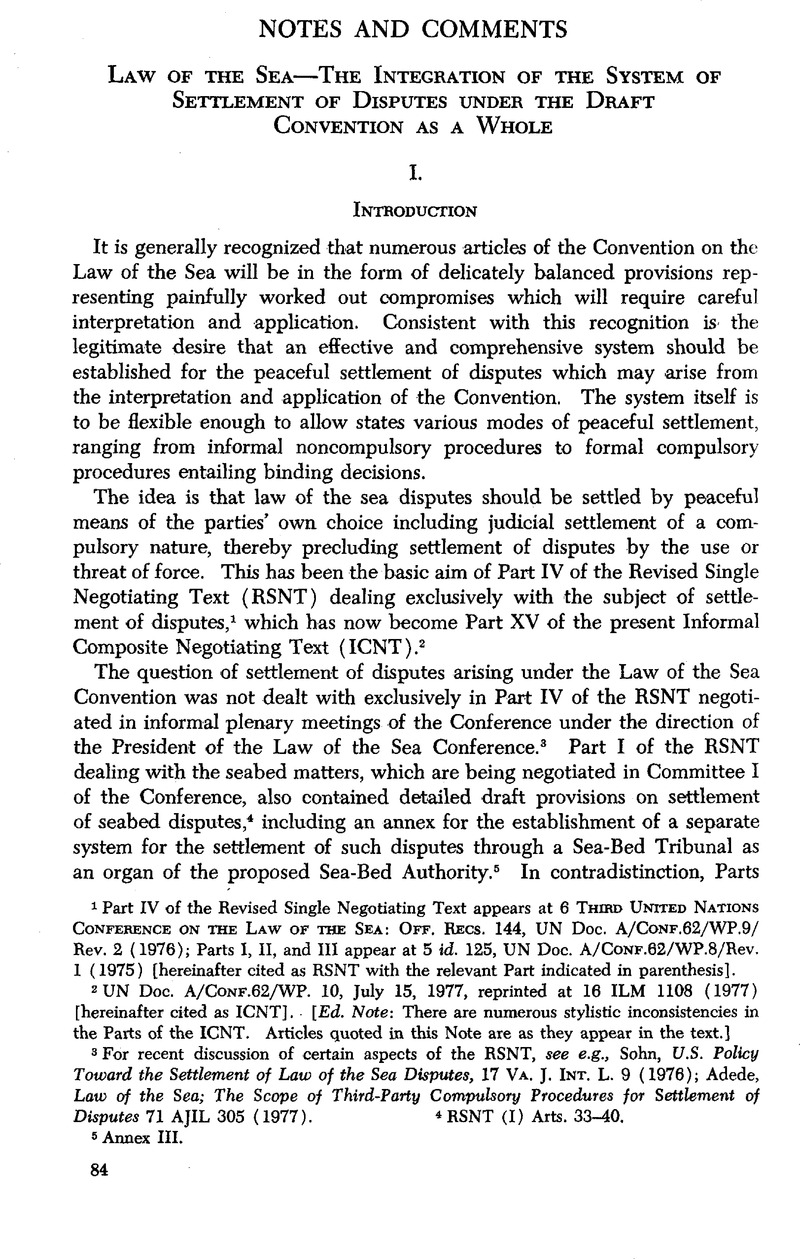Published online by Cambridge University Press: 27 February 2017

1 Part IV of the Revised Single Negotiating Text appears at 6 Third United Nations Conference on the Law of the Sea: Off. Recs. 144, UN Doc. A/CONF.62/WP.9/Rev.2 (1976); Parts I, II, and III appear at 5 id. 125, UN Doc. A/CoNF.62/WP.8/Rev. 1 (1975) [hereinafter cited as RSNT with the relevant Part indicated in parenthesis].
2 UN Doc. A/CONF.62/WP.10, July 15, 1977, reprinted at 16 ILM 1108 (1977) [hereinafter cited as ICNT]. [Ed. Note: There are numerous stylistic inconsistencies in the Parts of the ICNT. Articles quoted in this Note are as they appear in the text.]
3 For recent discussion of certain aspects of the RSNT, see e.g., Sohn, , U.S. Policy Toward the Settlement of Law of the Sea Disputes, 17 Va. J. Int. L. 9 (1976)Google Scholar; Adede, , Law of the Sea; The Scope of Third-Party Compulsory Procedures for Settlement of Disputes 71 AJIL 305 (1977)Google Scholar.
4 RSNT (I) Arts. 33-40.
5 Annex III.
6 See e.g., RSNT (II) Art. 131 and (III) Arts. 76 & 77.
7 This was contained in RSNT (IV), Annex II, Article 15, in which the establishment of a Sea-Bed Disputes Chamber was proposed as part of the Law of the Sea Tribunal.
8 The Law of the Sea Tribunal is to be composed of twenty-one members elected in the manner described in Articles 2–4 of the Statute of the Tribunal.
9 RSNT (I) Art. 26 (2) (ii) dealing with the functions of the Assembly and Art. 28 dealing with the functions of the Council.
10 Cf. ICNT (V) Art. 56 on rights, jurisdiction and duties of coastal states in the exclusive economic zone.
11 Art. 296 (1) (a).
12 Art. 296 (4).
13 Art. 296 (4)(c).
14 Art. 296 (4)(b).
15 Art. 296 (3)(b).
16 Art. 189 (1) (ii).
17 To enable the Enterprise to ask for advisory opinions, it would be necessary to revise this provision by naming the Enterprise in the article or by stating that an advisory opinion may be requested by “any organ of the Authority.” Cf.’ RSNT (I) Art. 34.
18 Cf. RSNT (I) Art. 25 (11).
19 ICNT, Art. 295. The power to “prescribe” provisional measures is stronger than the power of the International Court of Justice to “indicate” such measures under Article 41 of its Statute.
20 This distinguishes the power of the Chamber and the Tribunal from that of the International Court of Justice which may indicate provisional measures propio motu.
21 See ICNT, Article 290, paragraph 3, suggesting conditions under which the Tribunal, as a preconstituted forum, would have such jurisdiction.
22 See ICNT, Art. 291.
23 See, e.g., ICNT, Arts. 221-34.
24 See ICNT, Art. 296.
25 See ICNT, Art. 287.
26 See ICNT, Article 297 dealing with optional exceptions allowing a state to make a declaration excluding from the compulsory procedures the following subjects: boundary delimitation between adjacent or opposite states or historic bays or titles (subject to an obligation to accept some other tribunal), military activities, including government vessels and aircrafts jure imperii,some law enforcement activities, and disputes in respect of which the Security Council is exercising its functions pursuant to the Charter of the United Nations.
27 2 International Law, Being Collected Papers of Hersch Lauterpacht 18-19 (E. Lauterpacht ed. 1975).
28 See ICNT, Art. 281.